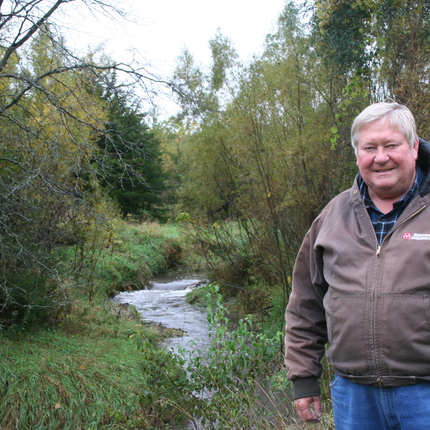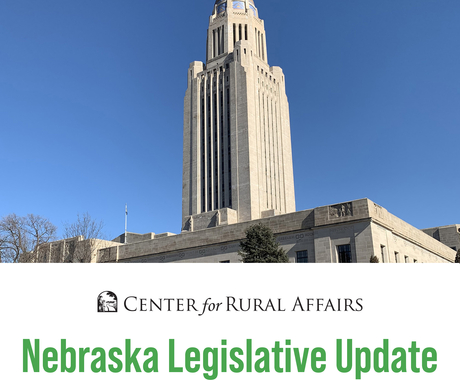By Lacie Dotterweich, former staff member
In this Iowa water quality blog series, we highlight Iowa farmers and water quality stakeholders to offer a variety of viewpoints and potential solutions. Previous blogs focus on Don and Bill Swanson, of Ottumwa, Iowa; Francis Thicke, of Fairfield, Iowa; Aaron Lehman, of Polk County, Iowa; and Ray and Sue Meylor, of Polk City, Iowa.
Mid-October in Iowa – temperatures have dropped, leaves are changing, and harvest should be in full swing. Yet, there I sat with Jerry Peckumn in his office when he should have been out in the combine. Thirteen days straight of heavy rains in central Iowa seriously stalled the harvest of the state’s corn and soybeans crops.
Despite the rain, Jerry isn’t too worried about his crops flooding. On his land near Jefferson, Iowa, he has installed terraces, a bioreactor, practices some no-till, and carefully manages nutrients using university-recommended rates. These stewardship practices have helped him prevent soil erosion and nutrient runoff on his farm, even with the excessive amount of rain.
The idea of being a good steward to the land was instilled in him at a young age. His family didn’t grow soybeans because his grandfather thought beans were really hard on the soil, making the soil looser and more subject to erosion and runoff. Much less so than corn. Jerry grew up on his parents farm, about 20 minutes from where he farms now.
“It was a wonderful place to grow up – my grandparents were around a lot,” Jerry said. “I really loved farming; it was all I wanted to do.”
Today, he raises cattle, and grows hay, corn, and soybeans with his two sons. They continue to treat the land the best they can, and have tried a variety of conservation practices.
Jerry is extra careful with his tilling to make sure his soil is loose and aerated, and to leave as much residue as possible.
“It’s a balancing act between keeping the organic matter but also needing to maintain crop yields,” Jerry said.
He also sets aside land for wildlife as an ecological refuge. Jerry began the practice by reserving land for pheasants, but he soon realized how good it was for the rest of the wildlife. Eventually, he noticed benefits on the land itself.
“I want my land to be an ecological refuge, to provide a place for native plants, animals, and insects to thrive,” Jerry said. “I like to know what wildlife is here, how we can protect it, and how we can farm in a way that keeps it from being destroyed.”
He knows that every farm in Iowa is different, and not everyone can plant cover crops or set aside land for wildlife. However, he thinks it is important for every farm to at least have a plan. Jerry feels targeting sensitive areas of farmland for treatment would make a big difference. Implementing practices such as prairie strips on steep slopes, waterways where needed, and cover crops on more erodible land could improve Iowa’s water quality.
“Highly erodible lands have to have conservation plans right now, and we need to apply that to all farms,” Jerry said. “All land is erodible, and all land loses nutrients.”
Conservation on your farm
Conservation plans can be extremely flexible, and be tailored to any farm. Many things are considered when creating a conservation plan, such as the needs and capabilities of each acre, and the farmer’s machinery and financial situation.
Feature photo: Jerry Peckumn with one of the many beaver dams he protects on his farm near Jefferson, Iowa. | Photo by Lacie Dotterweich




